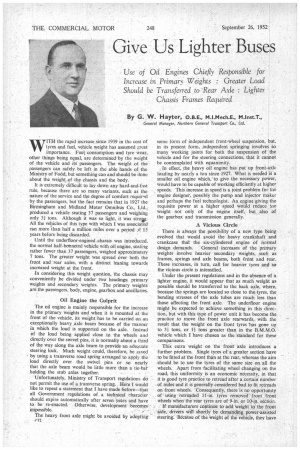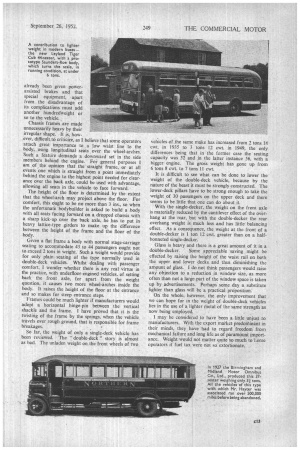Give Us Lighter Buses
Page 78

Page 79

If you've noticed an error in this article please click here to report it so we can fix it.
Use of Oil Engines Chiefly Responsible for Increase in Primary Weights : Greater Load Should be Transferred to Rear Axle : Lighter Chassis Frames Required By G. W. Hayter, 0.B.E., M.I.Mech.E., M.Inst.T., General Manager, Northern General Transport Co., Ltd.
WITH the rapid increase since 1939 in the cost of tyres and fuel, vehicle weight has assumed great importance. Fuel consumption and tyre wear, other things being equal, are determined by the weight , of the vehicle and its passengers. The weight ot the passengers can safely be left in the able hands of the Ministry of Foiid, but something can and should be done about the weight of the chassis and the body.
It is extremely difficult to lay down any hard-and-fast rule, because there are so many variants, such as the nature of the service and the degree of comfort required by the passengers, but the fact remains that in 1927 the Birmingham and Midland Motor Omnibus Co., Ltd.,. produced a vehicle seating 37 passengers and weighing only 31 tons. Although it was so light, it was strow. All the vehicles of this type with which I was associated ran more than half a million mites over a period 3f 15 years before being discarded. '
Until the underffoor-engined . chassis was introduced, the normal half-botmeted vehicle with oil engine, seating rather fewer than .37 passengers, weighed approximately 7 tons. The greater weight was spread over both the front and rear axles, with a distinct leaning towards increased weight at the front.
In considering this weight question, the chassis may conveniently be divided under two headings: primary weights and secondary weights. The primary weights are the passengers, body, engine, gearbox and ancillaries.
Oil Engine the Culprit The oil engine is mainly responsible for the increase in the primary weights and when it is mounted at the front of the vehicle, its weight has to be carried on an exceptionally heavy .axle beam because of the manner in which the load is supported on the axle. Instead of the load being applied close to the wheels and directly over the swivel pins, it is normally about a third of the way along the axle beam to provide an adequate steering lock. Much weight could, therefore, be saved by using a transverse road spring arranged to apply the load directly over the swivel pins or so nearly that the axle beam would .be little more than a tie-balholding the stub axles together.
Unfortunately, Ministry of Transport regulations do not permit the use of a transverse spring. Here I would like to repeat a statement that I have made before—that all Government regulations of a technical character should expire automatically after seven years and have to be re-enacted. Otherwise, development becomes impossible.
The heavy front axle might be avoided by adopting r12 some form of independent front-wheel suspension, but, in its present form, independent springing involves So many working joints for both the suspension of the vehicle and for the steering connections, that it cannot be contemplated with equanimity. In effect, the heavy oil engine has put up front-axle loading by nearly a ton since 1927. What is needed is a smaller oil engine which,' to give the necessary power, would have to be capable of working efficiently at higher speeds. This increase in speed is a joint problem for Me engine designer, possibly the pump and injector maker and perhaps the fuel technologist. An engine giving the requisite power at a higher speed would reduce tile weight not only of the engine itself, but also of the gearbox and transmission generally.
A Vicious Circle
There is always the possibility of a new type being evolved that would avoid the heavy crankshaft and crankcase that the six-cylindered engine of normal design demands. General increases of the primary weights involve heavier secondary weights, such as frames, springs and axle beams, both front and rear. These increases, in turn, call for heavier tyres and so the vicious circle is intensified.
Under the present regulations and in the absence of a lighter engine, it would appear that as much weight as possible should be transferred to the back axle, where, because the springs are located so close to the tyres, the bending stresses of the axle tubes are much less than those affecting the front axle. The underfloor engine might be expected to achieve something in this direction, but with this type of power unit it has become the practice to move the front axle rearwards, with the result that the weight on the front tyres has gone up to 3+ tons, or If tons greater than in the B.M.M.O. vehicle which I have chosen as the standard for these comparisons.
This extra weight on the front axle introduces a further problem. Single tyres of a greater section have to be fitted at the front than at the rear, whereas the aim should be to use the tyres of the same size on all the wheels. Apart from facilitating wheel changing on the road, this uniformity is an economic necessity, in that it is good tyre practice to retread after a ,certain number of Miles and it is generally considered bad to fit retreads on front wheels. 'Consequently, there is no opportunity of using 'retreaded 11-in. tyres removed from' frOnt wheels when the rear tyres are of 9-in', or 11Y-in. section. ,
If manufacturers cOhtinue to add weight to the front axle,drivers Will shortly be demanding power-assisted steering. Because of the weight of the vehicle, they have
already been given power assisted brakes and that special equipment, apart from the disadvantage of its complications must add another hundredweight or so to the vehicle.
Chassis frames are made unnecessarily heavy by their irregular shape. It is, how
ever, difficult to criticize, as I believe that some operators
attach great importance to a low waist line to the body, using longitudinal seats over the wheel-arches.
Such a feature demands a downward set in the side members behind the engine. For general purposes I am of the opinion that the straight frame, or at all events one which is straight from a point immediately behind the engine to the highest point needed for clearance over the back axle, could be used with advantage, allowing all seats in the vehicle to face forward.
The height of the floor is determined by the extent that the wheel-arch may project above the floor. For comfort, this ought to be no more than 3 ins., so when the unfortunate bodybuilder is asked to build a body with all seats facing forward on a dropped chassis with a sharp kick-up over the back axle, he has to put in heavy lattice-type girders to make up the difference between the height of the frame and the floor of the body.
Given a flat frame a body with normal stage-carriage seating to accommodate 43 to 44 passengers ought not to exceed 2 tons in weight. Such a weight would provide for only plain. seating of the type normally used in double-deck vehicles. Whilst dealing with passenger comfort, I wonder whether there is any real virtue in the practice, with underfloor-angined vehicles, of setting back the front axle, for apart from the weight question, it causes two more wheel-arches inside the body. It raises the height of the floor at the entrance and so makes for steep entrance steps.
Frames could be much lighter if manufacturers would adopt a horizontal hinge-pin between the vertical shackle and the frame. I have proved that it is the twisting of the frame by the springs, when the vehicle travels over rough ground, that is responsible for frame breakages.
So far, the weight of only a single-deck vehicle has been reviewed. The " double-deck " story is almost as bad. The unladen weight on the front wheels of two
vehicles of the same make has increased from 2 tons 18 cwt. in 1935 to 3 tons 12 cwt. in 1949, the only differences being that in the former case the seating capacity was 52 and in the latter instance 56, with a bigger engine. The gross weight has gone up from 6 tons 8 cwt. to 7 tons 11 cwt.
It is difficult to see what can be done to lower the weight of the double-deck vehicle, because by the nature of the beast it must be strongly constructed. The lower-deck pillars have to be strong enough to take the weight of 30 passengers on the upper deck and there seems to be little that one can do about it.
With the single-decker, the weight on the front axle is materially reduced by the cantilever effect of the overhang at the rear, but with the double-decker the rear overhang weight is much less and has little balancing effect. As a consequence, the weight at the front of a double-decker is I ton 12 cwt. greater than on a halfbonneted single-decker.
Glass is heavy and there is a great amount of it in a
double-decker. Some appreciable saving might be effected by raising the height of the waist rail on both the upper and lower decks and thus diminishing the amount of glass. I do not think passengers would raise any objection to a reduction in window size, as more often than not a large part of the window space is taken up by advertisements. 'Perhaps some day a substitute lighter than glass will be a practical proposition.
On the whole, however, the only improvement that we can hope for in the weight of double-deck vehicles lies in the use of a lighter metal of the same strength as now being employed. . •
I may be considered to have been a little unjust to manufacturers. With the export market predoniinant in their minds, they have had to regard freedom from mechanical failure and long life as of paramount importance. Weight would not matter quite so much to home operators if fuel tax were not so extortionate.




































































































































































































































































































